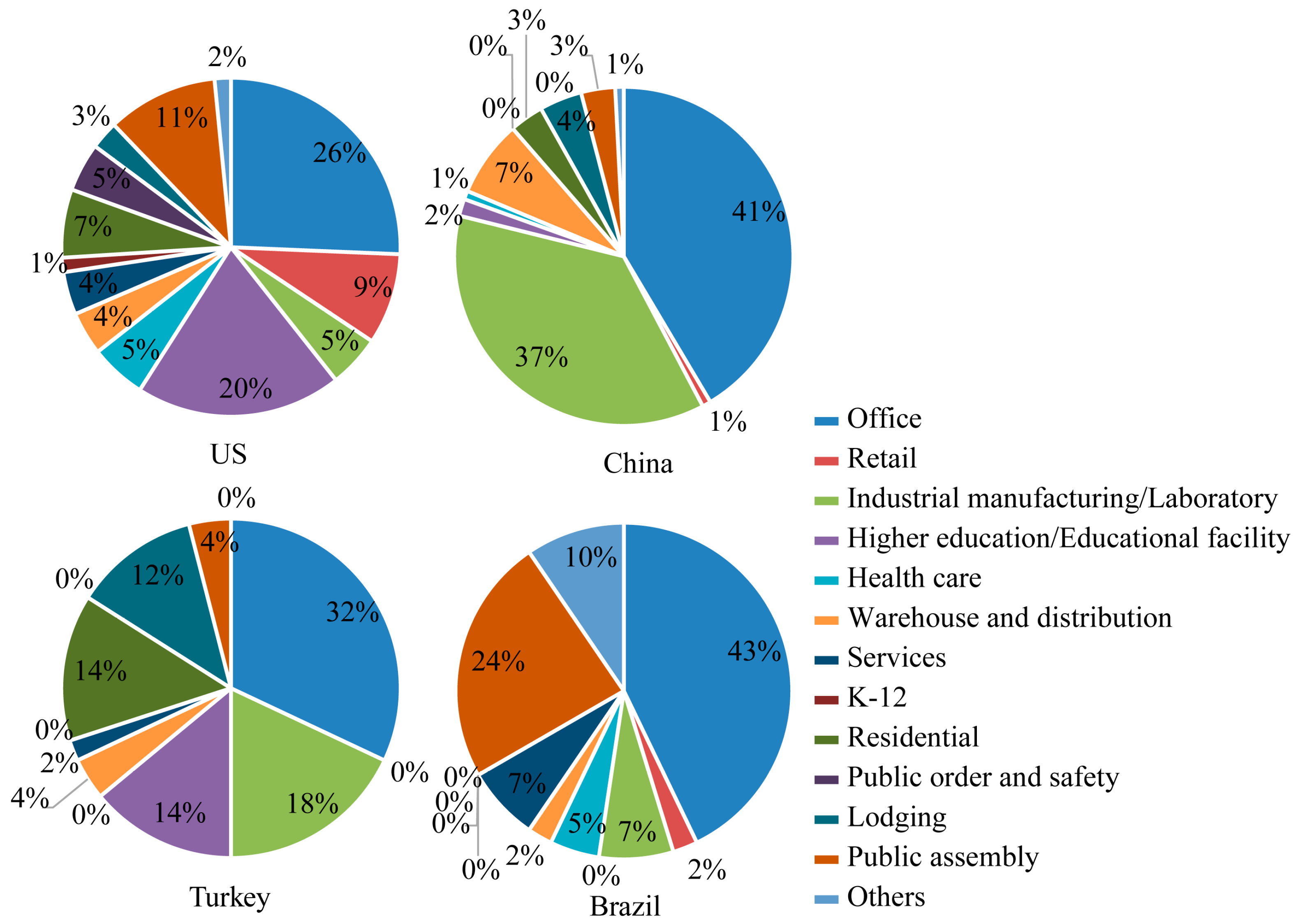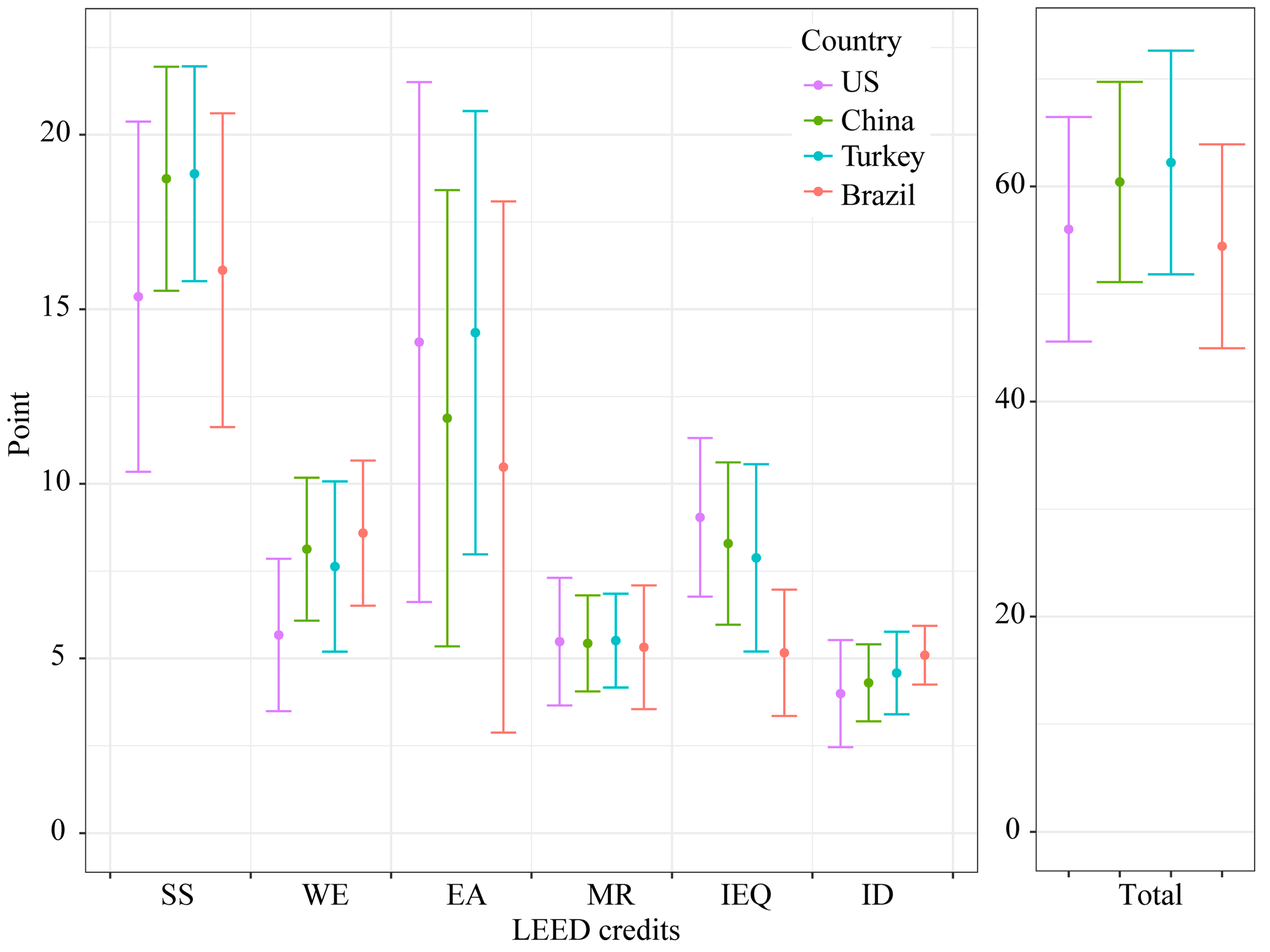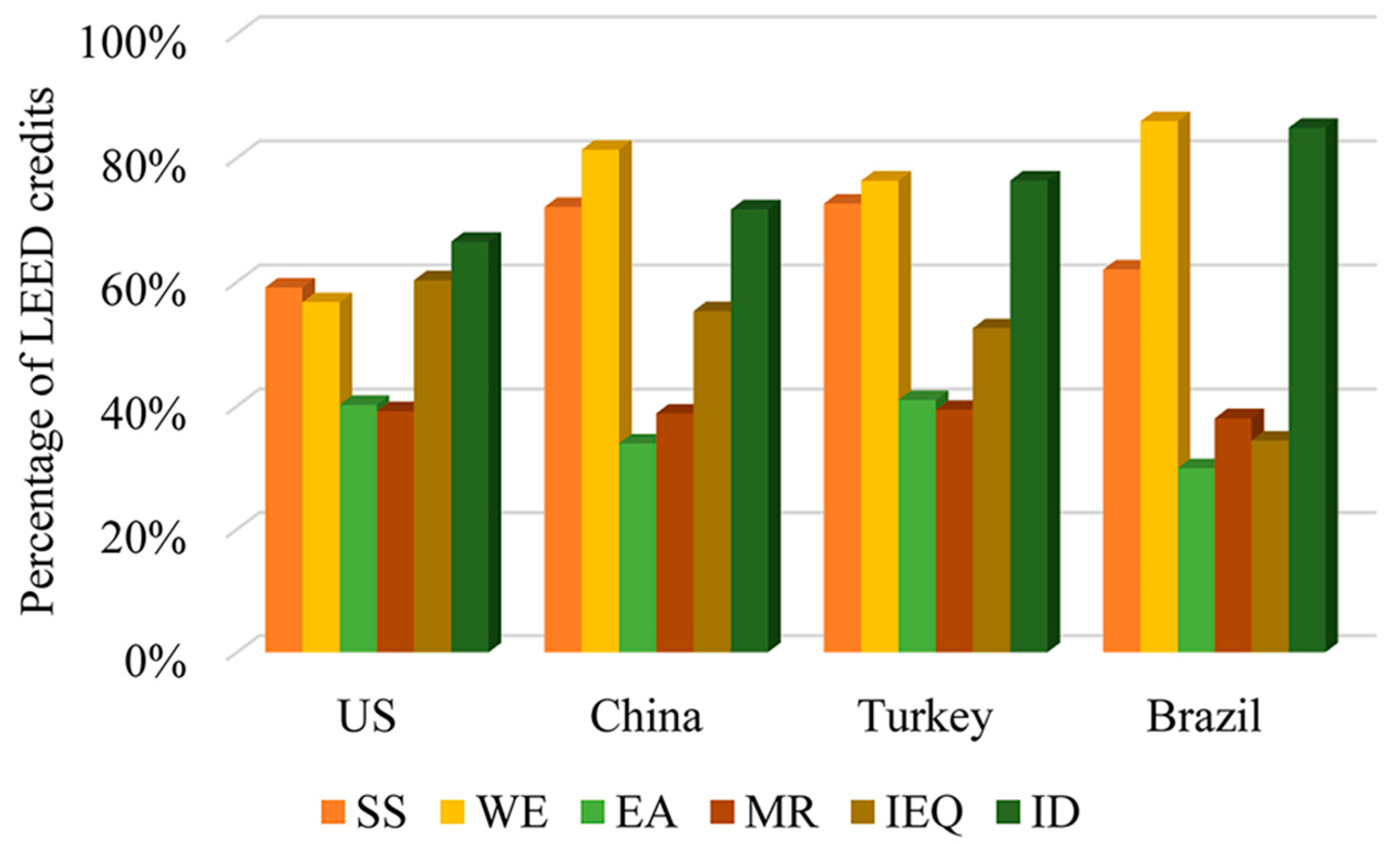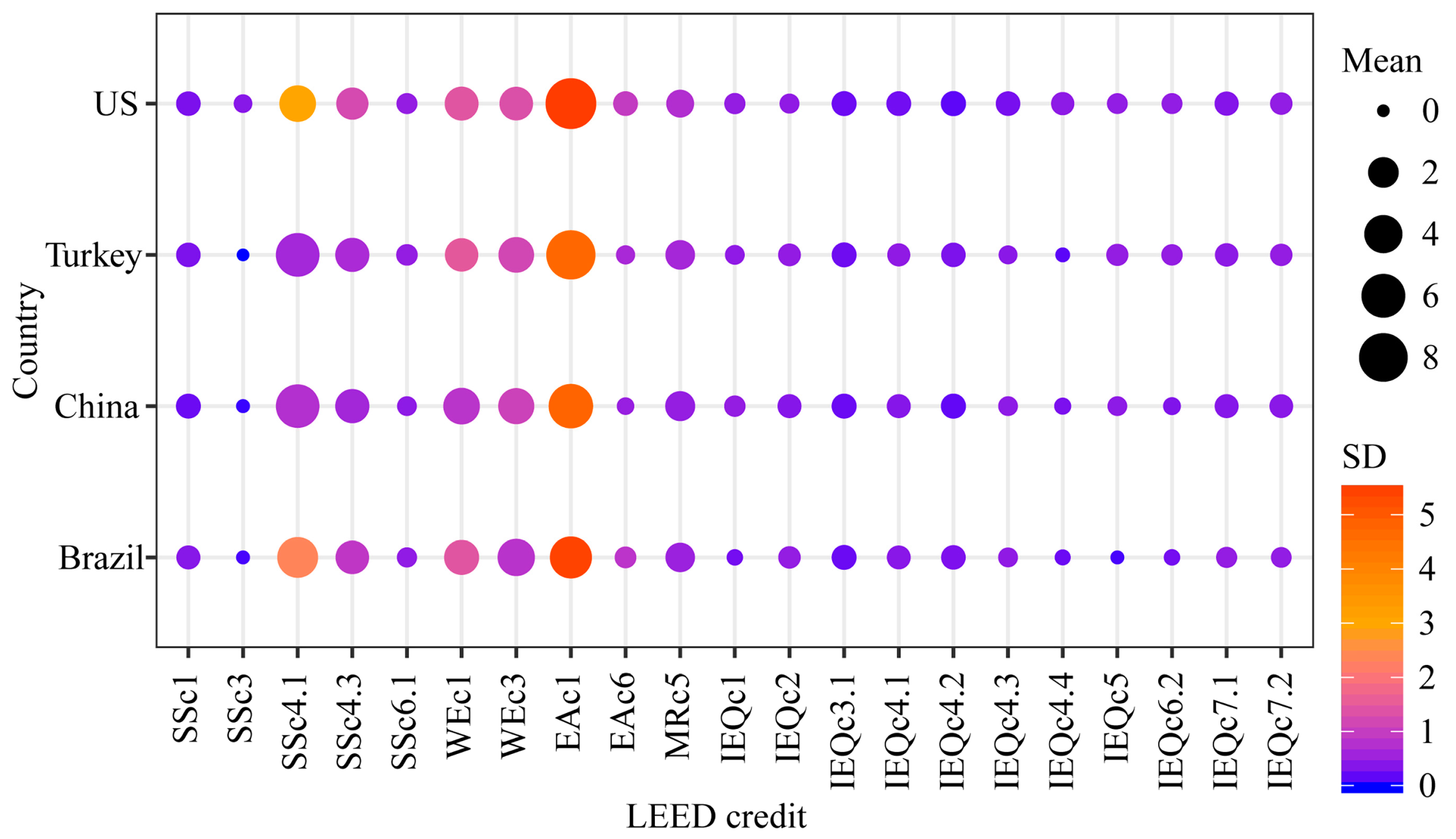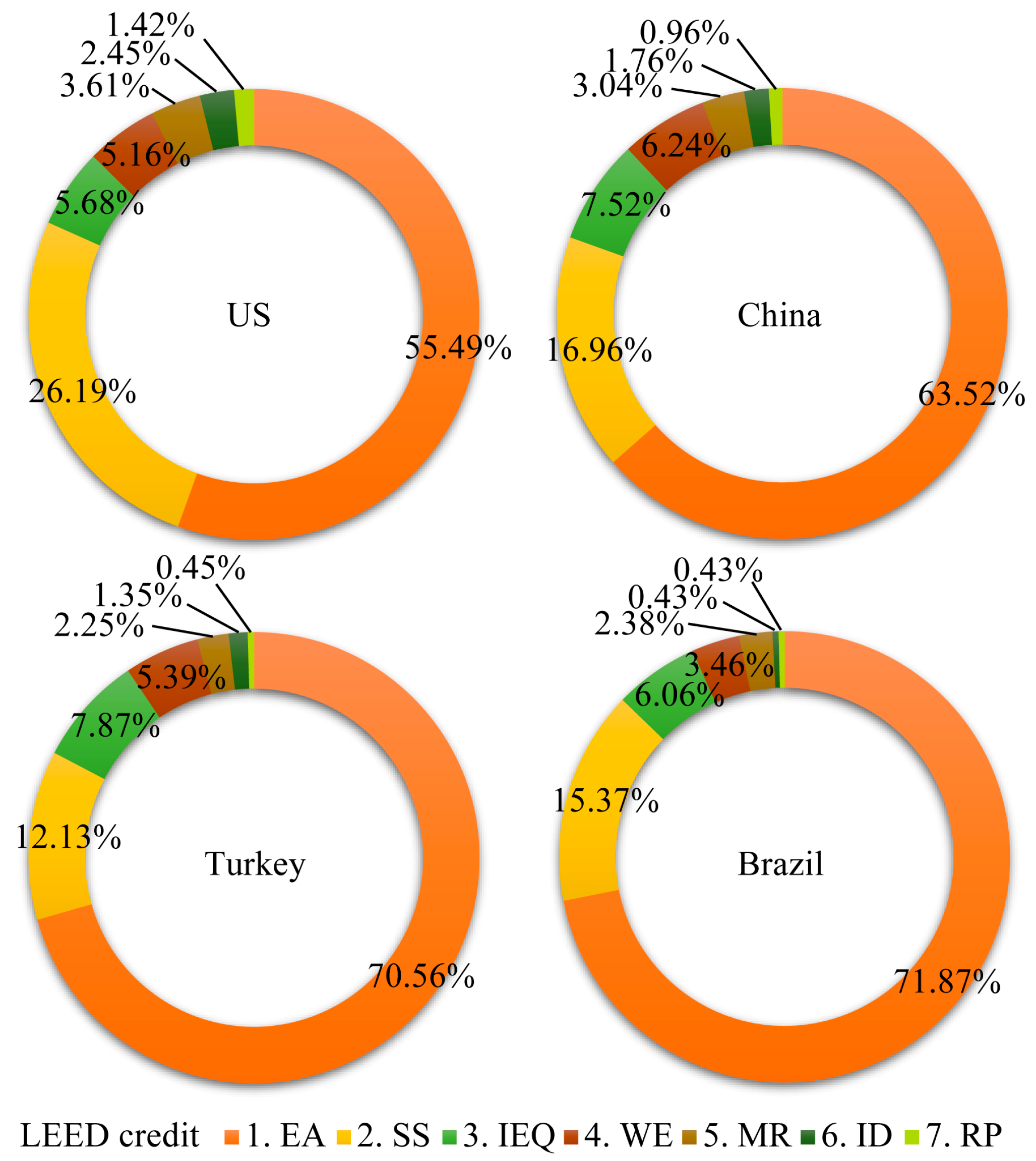4.1. Geographical Distribution
The geographical distribution of the LEED 2009 certified projects is shown in
Table 5. At the country level, the majority of the LEED 2009 certified projects are located in the United States (3690; 79.2%). Other countries with more than 50 certified projects are China (170; 3.7%), Turkey (86; 1.8%), and Brazil (75; 1.6%). One interesting finding is the increasing impact of LEED in countries other than the US. According to Wu et al., 94.3% of all LEED v2.2 certified projects are based in the US. The number has been reduced significantly to 79.2% in LEED 2009 [
16]. It seems that with the introduction of alternative compliance paths and regional priority credits in various countries and regions, the global impact of LEED has been increasing.
Table 5 shows the certification levels of all LEED 2009 projects. While Silver and Gold projects dominate the certification levels in all four countries, the certification pattern is different. In the US and Brazil, Silver projects have a large market share, while in China and Turkey, Gold projects tend to have a large market share.
Figure 1 shows the project types of the four countries. In US, office, higher education/educational facility, public assembly and retail have the largest market share of LEED 2009 certified projects (26%, 20%, 11%, and 9%, respectively). Similarly, the top four project types in China are office (41%), industrial manufacturing/laboratory (37%), warehouse and distribution (7%), and lodging (4%). A similar trend is identified in Turkey with office, industrial manufacturing/laboratory, higher education/educational facility, and residential accounting for 32%, 18%, 14%, and 14% respectively. In Brazil, the top three project types are office (43%), public assembly (24%), and others (10%).
4.2. Regional Variations—Rankings
The rankings of the performance of LEED 2009 certified projects on the six main LEED categories at the country level are provided in
Table 6,
Figure 2 and
Figure 3.
As can be seen from
Table 6 and
Figure 2, in terms of mean overall LEED credits achieved, Turkey has the highest credits (62.23), followed by China (60.42), US (56.02), and Brazil (54.44). Other notable differences can also be identified from
Table 5, including:
Brazil and the US have relatively low overall LEED credits, indicating possible low level of achievements in LEED certified buildings.
For Brazil, the low level of achievement is caused by low credit achievement in sustainable site (16.12), energy and atmosphere (10.48), and indoor environmental quality (5.16).
For the US, the low level of achievement is caused by low credit achievement in sustainable site (15.36) and water efficiency (5.67).
Different countries seem to have advantages in different LEED credits. For example, China has high credit achievement in sustainable sites (18.74) and water efficiency (8.13), but has relatively low credit achievement in energy and atmosphere (11.88). On the other hand, the US has low credit achievement in sustainable sites (15.36) and water efficiency (5.67), but has relatively high credit achievement in energy and atmosphere (14.06).
While there are significant differences in the performance of LEED building across the four countries in sustainable sites, water efficiency, energy and atmosphere, indoor environmental quality, as well as innovation in design, there is no significant difference in material and resources. In accordance with previous studies [
13,
31,
32,
33], it is found that MR credits are very difficult to obtain and only 35% of the MR credits are obtained by certified projects.
Figure 3 shows the percentage of achievement across the six main assessment categories. The results show that EA and MR credits are extremely difficult to achieve, when only 40% of the allocated credits can be achieved by certified projects. Such a pattern is found to be consistent across the four countries. In addition, it is surprising to see that IEQ is not commonly targeted in Brazil, with only a 30% percentage of achievement. As can be seen from
Table 5, Brazil and US have similar certification structures. The difference may be caused by the differences in the types of certified projects, as demonstrated in
Figure 1.
For the six main LEED categories, the CV values range from 0.16 to 0.73. This suggests that the general dispersion of all six main LEED categories is very minimal. In the six categories, SS normally has the lowest CV, while EA has the highest CV, indicating that EA-related credits have a large spread.
The performance of the LEED certified projects on the 21 regionally specific credits is shown in
Table 7 and
Figure 4. As can be seen from
Table 7, the significance levels of most credits (except IEQc3.1) are lower than 0.05, indicating that there are significant differences between the four countries on these regionally specific LEED credits. In addition, some “point chasing” patterns can be identified from
Table 7 and
Figure 4. For example, in SS, most projects have achieved appropriate site selection (SSc1), while very limited projects, especially in non-US countries, have achieved brownfield redevelopment (SSc3). In EA, many US projects have started to use green power (EAc6) for LEED 2009 certification when compared to previous LEED v2.2. According to [
16], the mean credit achievement for green power is only around 0.44 in LEED v2.2. This may imply that the availability and the affordability of green power have increased significantly over the years, which enables more projects to implement green power. The finding is in accordance with [
34], who found that renewable electricity certificate (REC) sales, which is commonly used as a source for EAc6, has increased from 3.9 million MWh in 2005 to 36.0 million MWh in 2014. At the same time, REC prices have declined from 10
$/MWh to less than 1
$/MWh.
4.3. Regional Variations—Country Comparison
The results of the Kruskal-Wallis test (see
Table 6) indicate that there are significant differences across the four countries for the mean value of most LEED main assessment categories (except for MR where no significant difference is identified).
The results of the GAM development are shown in
Table 8 and
Figure 5. The sequence of the seven credits on the total deviance explained does not vary across the four countries. The most power predictor is EA, which is in consistent with previous studies, such as [
35,
36]. However, the deviance that is explained by the contributors varies significantly, especially in EA and SS. For example, it is usually correct to predict that a higher EA achievement will lead to higher certification level in Brazil and Turkey. However, in the US, the prediction will be complicated by the fact that EA only accounts for 55.48% of the rating. In addition, it should also be noted that the sequence of the prediction has been changed when compared to LEED v2.2. According to [
16], for LEED v2.2 projects, the sequence of the predictors is EA, IEQ, SS, MR, ID, and WE. The sequence has been changed significantly to EA, SS, IEQ, WE, MR, and ID. It suggests that when compared to LEED v2.2, in order to achieve better desirable rating, although much attention should still be focused on energy and atmosphere, more attention is needed on sustainable sites and water efficiency.
In addition to the six main LEED credits, the post hoc analysis is conducted on the 20 regionally specific credits. The results are shown in
Table 9. IEQc3.1 (construction indoor air quality management plan during construction) is excluded because no difference is identified from the Kruskal-Wallis test.
As can be seen from
Table 9, in site selection (SSc1), no significant difference is spotted in most pairs. Most projects are able to select a suitable building location. However, US projects demonstrate a significant difference in other SS credits, including brownfield redevelopment (SSc3), public transportation access (SSc4.1), and low-emitting and fuel-efficient vehicles (SSc4.3). US projects have significantly better performance in rehabilitating damages sites. However, only 22% of the overall certified projects have achieved the credit, indicating the difficulty to achieve the credit. According to [
37], there is evidence that brownfield projects normally reach higher sustainability standards of green building. Brownfields sites tend to be dense and are normally mixed use, which can reduce greenhouse gas emissions by 20–40 percentages [
38]. However, the credit is only allocated with 1 point, which calls for further improvement. In addition, US projects have not performed well in providing accessible public transportation and using low-emitting and fuel-efficient vehicles. The results highlight useful improvement areas for US projects.
In WE-related credits, projects in China have significantly better performance in water efficient landscaping (WEc1). In addition, all other three countries perform better on water use reduction (WEc3) when compared to the US. Water scarcity appears to be a common problem for all countries [
39,
40]. However, it should be noted that the US has a higher water stress indicator when compared to China, Brazil, and Turkey [
35]. As such, it is surprising to see that US projects have not performed well on water efficiency when compared to the projects in other countries.
In EA-related credits, US projects have significantly better performance in utilizing green power (EAc6) due to much better availability and affordability. In addition, US projects and Turkey projects have significantly better performance in optimizing energy performance (EAc1). Further analysis is needed to investigate the reasons leading to the significant regional variation in energy performance. However, it should be noted that green buildings in China do not need to pursue maximum energy performance due to the
National Green Building Evaluation Standard (GB/T 50378-2006). The system does not use a scoring system, but it focuses on the number of options to achieve and satisfy [
41]. As long as the
China Design Standard for Energy Efficiency is met, then the building will achieve the score in energy efficiency, regardless of how much improvement is demonstrated.
The practice related to the use of regionally available materials (MRc5) has been changed significantly. According to [
42], MRc5 was rarely achieved in LEED certified buildings. However, the mean score of MRc5 is increased to 1.43 to 1.85 (out of 2), depending on the specific country. In addition, projects in China, Turkey, and Brazil perform significantly better in utilizing regional materials, which may imply that resource availability in these countries is much better.
In addition, it seems that countries have their own patterns in pursuing IEQ-related credits. For example, US projects perform significantly better in using low-emitting materials, including adhesive and sealants (IEQc4.1), paints and coatings (IEQc4.2), flooring systems (IEQc4.3), and composite wood and agrifiber products (IEQc4.4). This suggests that the availability and uptake of low-emitting materials in the US may be better than other countries. However, US projects significantly underperform in increased ventilation (IEQc2). In addition, projects in Brazil significantly underperform in outdoor air delivery monitoring (IEQc1), thermal comfort control (IEQc6.2), and thermal comfort design (IEQc7.1). Projects in China significantly underperform in thermal comfort control (IEQc6.2). The results provide useful benchmarks for countries with undesirable performance to improve.
4.4. RP Credits
RP credits are bonus points if the LEED projects address regionally specific issues. A frequency analysis is conducted on each RP credit in each country. This will be useful to identify the importance of the credit to the regional development and whether there is a point chasing problem in specific RP credits.
For US projects, the most commonly achieved RP credits are quantity control in stormwater design (SSc6.1; 20.3%), public transport access (SSc4.1; 18.9%), and construction waste management (MRc2; 18.4%). The achievement highlights their importance in developing green buildings that address regional differences. However, it should be noted that the RP credits in the US are dependent on the zip code of the projects. As such, estimating the frequency of the RP credits in the US has limited guidance on how RP credits should be improved to balance multiple regional priorities.
The performance of the projects in China on its RP credits is shown in
Table 10. It seems that water efficient landscaping (WEc1) is a common credit that is targeted by most projects. On the other hand, quantity control in stormwater design (SSc6.1) is rarely achieved.
Similarly, for the RP credits in Turkey (see
Table 11), the most commonly achieved RP credit is heat island effect—roof (SSc7.2) and other RP credits, especially construction waste management (MRc2) and building reused related to interior non-structural elements (MRc1.2), are rarely achieved.
For RP credits in Brazil (see
Table 12), water use reduction (WEc3) and innovative wastewater technologies (WEc2) are achieved by most projects (88.0% and 84.0% respectively). On the other hand, On-site renewable energy (EAc2) and quantity control in stormwater design (SSc6.1) are rarely achieved.
